On a Wednesday in early February, a group of sixth grade students at Saddle River Day School in New Jersey sat around a small collection of desks arranged like a table. This makeshift table came complete with a patterned tablecloth, place settings of silverware and cloth napkins, and a centerpiece of a potted orchid. The students dug into their hearty meals of chicken marsala, sautéed vegetables, and jasmine rice garnished with chives.
A few paces away, a group of their classmates sat on the floor, passing around bowls of rice and beans. Across the room, another group gathered around a simple bowl of rice. They picked at their paltry lunch with their hands, every so often glancing enviously at their more fortunate classmates digging into a well-balanced and nutritious meal.
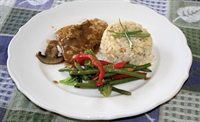
Food and nutrition were topics of a sixth grade interdisciplinary activity at Saddle River Day School.
The students around the room reflected on the experience. One student in the second group quickly grasped the nature of the activity, explaining, “people in other countries that are in poverty would usually eat like this.” Another student, faced with the prospect of eating only handfuls of rice for the entire day, explained, “I don’t know what I would do. I would just be hungry and exhausted the whole day.” Around the room, students discussed nutrition, caloric intake, and global perspectives of food and the disparity of its distribution.
This lunch was the culminating activity in a two-and-a-half week interdisciplinary investigation of food and nutrition that the entire sixth grade had undertaken. Throughout this exploration, students looked at the everyday topic of food through the lenses of their academic classes. In social studies, they researched and presented on the culture and social values surrounding food. In English, they read Linda Sue Park’s A Long Walk to Water. They kept food diaries in both science and math, examining the building blocks of nutrition while working to uncover the truth behind serving sizes and nutritional information found on food packages in the supermarket.
One of the core concepts presented in AMLE’s This We Believe is that learning should not occur in isolation, and skills such as reading, writing, speaking, and listening “should be advanced and practiced wherever they apply.” An interdisciplinary approach provides authentic learning opportunities for students, helps remind teachers and students alike that the nature of learning is both horizontal and vertical, and provides students with the time and space necessary to engage with their courses in a creative and meaningful way.
Segmented vs. Authentic Thinking
Last summer, during a weekend getaway with friends, I found myself playing a game akin to Catchphrase, desperately trying to convince my partner to guess the title of the Brad Pitt movie Se7en. I tried describing the movie for someone who had never seen it: “Brad Pitt was in it. Morgan Freeman, Gwyneth Paltrow … ” I explained further, “It was a murder mystery. Kind of disturbing … ” I even shouted a defining quote from the end of the movie, “What’s in the box!!?” All of these tactics were in vain, and we ultimately ran out of time.
Looking back, I realized all I needed to do was get my partner to say the word “seven.” Anything would have worked: “six plus one, eight minus one, the number after six, the number of days in a week.” But I got tripped up by the same kind of segmented thinking we often mistakenly instill in middle school classrooms.
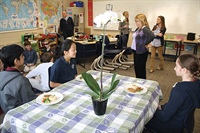
Students examined their values, assumptions, and views of the world around them.
As middle school teachers, we can fall victim to segmenting the curriculum. As education management consultant Simon Jeynes says, we view education vertically, identifying ourselves as teachers of history or mathematics, ELA, or science. However, our students experience education horizontally, navigating on any given day many such disciplines, each with its own siloes of facts, skills, and subject-centered jargon. As a result, we sometimes force our students to view their learning as compartments of knowledge to master rather than as the development of lifelong skills.
Students have a hard time recognizing that the skills they use to solve a mathematical equation are the same ones necessary to support their findings from a scientific experiment or to build to a reasonable conclusion in an essay. As adults, we don’t approach our work this way. We don’t view typing an e-mail as “English work,” or paying a bill at a restaurant as “math.” These are simply parts of our everyday lives. However, because we divide the school experience into different subjects taught by a variety of teachers with a wide spectrum of expectations, we build unnecessary walls between the disciplines.
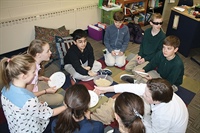
With just a bowl of rice to share, students better understood the hardships faced by others.
In facing the demand to cover an ever-growing breadth of content in a single school year, it is natural for a teacher to develop tunnel vision. We see the enormity of what we have to do, the shrinking amount of time to do it in, and we plow forward. In this model, we lose sight of the fact that, according to This We Believe, “teachers must help students examine values, assumptions, basic principles, and alternative points of view, addressing why things happen as well as how.” It is incumbent upon us to provide students with opportunities to explicitly transfer their skills and knowledge between subjects.
Opening the Door
Devoting a month to a concept such as food may seem unrealistic. Yet it actually allows room for students and teachers to make natural and meaningful connections. Devoting the most valuable resource in school—time—to a single topic or theme asks teachers and students to think critically and creatively about the goals of their courses.
To plan a successful interdisciplinary study, teachers must step outside their classrooms and department meetings, to develop ways to introduce and build on the skills necessary for their students
to succeed.
During the unit on food, Saddle River teachers took on new roles and challenges. A second-year Spanish teacher worked with a veteran English teacher to learn Glogster—an online tool used to create digital posters—which students in her class then used to present information about the culture and food of Spanish-speaking countries.
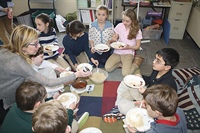
Students were able to make connections across disciplines and to their own lives.
A young math teacher teamed with an experienced science teacher to develop food diaries, which required students to explore concepts such as ratios and percentages, fats and carbohydrates, and caloric intake and digestion in written form.
This type of openness to exploration and teaming naturally put a premium on student voice and choice. Over the course of the unit, students decided to track the amount of food wasted at their own lunches, bringing to bear their understanding of the global competition for resources and mathematical concepts such as data collection and statistical analysis, while also deciding what would make the healthiest and most sustaining lunch.
In the end, this exploration asked students to make connections between all aspects of the school day. Reflecting on his lunch of only rice, one student explained not why he disliked his meal, but why it would not be enough: “The healthy group got meat, vegetables … protein, minerals, and vitamins. But we just got rice, just carbohydrates.” Thus, this student not only innately and immediately understood the disparity between his lunch and that of his classmates, but also could explain the scientific reasons for this inequality and connect this experience to the global distribution of food.
A Place in the World
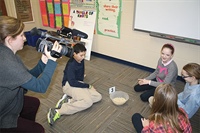
Throughout the activity, students shared their thoughts about the powerful experience
Ultimately, interdisciplinary work reminds us that we teach students, not content. Interdisciplinary investigations provide middle school students with authentic learning opportunities where they can explicitly and creatively transfer skills and make connections between their subjects. Such opportunities model the type of thinking and learning required of adults in the workforce on a daily basis. By looking at a relevant topic, such as food, we ask students to think about their own experiences and their place in the world.
One sixth grader reflected, “a lot of people don’t have nearly as much food as we do. [Also, the] middle school’s food waste could be someone else’s feast. We should be grateful for being able to have food on our plates.” Another tidily summed up her thoughts in this way: “Food is fuel and it is also culture.”
Joshua Deitch is the middle school division dean at Saddle River Day School in Saddle River, New Jersey. jdeitch@saddleriverday.org
Published in AMLE Magazine, September 2014